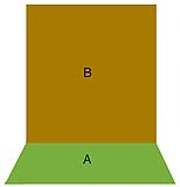Now to coaxing a “circle” from a rectangle. Understanding how different stitch structures affect the length and width of fabric can help make it possible to “cheat” in shaping. The circle’s circumference needs to be significantly wider than the inner “square/rectangle”. The disparity in width between every needle rib and single bed fabric is one way to help create the desired conclusion. Tuck stitches yield a knit that is short and fat. Combining them in every needle rib with one or both beds tucking increases width dramatically when compared to single bed fabrics. One possible way to construct it is to begin with every needle rib: figure A, switching to single bed fabric: figure B, and returning to the same “shaping” as A.
The completed outer edge needs to have stretch so as not to break as it folds over into a collar and surrounds the shoulders. Routine knitting of this form as one piece will give one cast on and one bound off edge. It is possible by a variety of methods to have both edges match. My first sample even though binding off was quite loose, wound up with the yarn breaking on wearing. A more successful approach was to knit section A as a tuck rib, B as a fabric that was mostly knit single bed, and removing the piece onto waste yarn and off the KM at that point. Section A was knit once more in the same manner as at the bottom of the first piece, and then joined to A+B
The finished “garment” gets folded in half, and seamed toward its center, leaving an opening for armholes. Upon its wearing, the joining seams on sides rotate to the front of the body, so a good join is important. The alignment of the pattern repeat may have to be taken into account in addition to stitch gauge in grading for different sizes.
